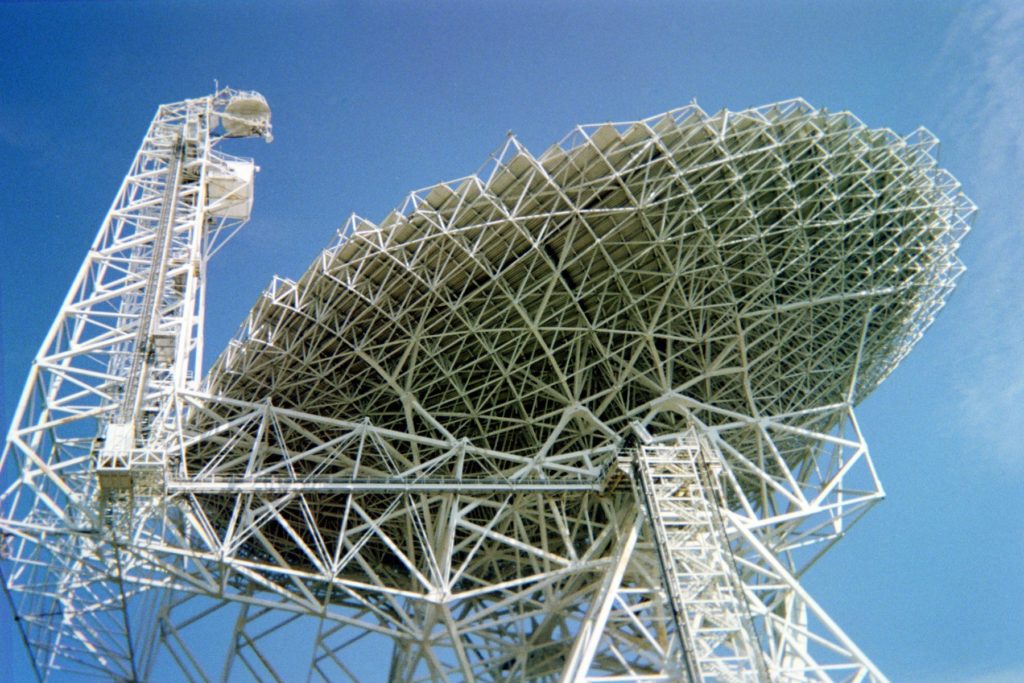
When the idea of a professional astronomer comes to mind, perhaps the first thing one pictures is a person sitting in a rural area in the middle of the night, squinting through a telescope, hoping to find some new star, planet, or asteroid. While this is certainly the case for the occasional astronomer or student enjoying a clear weekend, the story of radio astronomy and interferometry looks quite different. With its roots deep in the UW-Madison physics department, beginning with UW-Madison alumnus, Karl Jansky, who built the first radio telescope in 1928, radio astronomy has spread across the planet to explore the universe from the smallest particles to the largest driving forces of cosmology.
In the aftermath of World War 2, the United States found itself with a plethora of technicians full of knowledge of radio technology and communication, yet with no further use for their knowledge. As the United States began to look around the world in the early 1950s, they realized that they were falling behind when it came to radio astronomy infrastructure. By the early 1960s, the National Radio Quiet Zone had been established and the National Radio Astronomy Observatory (NRAO) had set up shop in Green Bank, West Virginia. At the heart of this 26,000 square mile zone, most forms of modern technology are restricted to listen for the whispers of the universe.
Interferometry in the United States was first explored at the Green Bank Observatory, and is further explained by scientist Dr. Will Armentrout. Armentrout works in mapping star-forming regions in the Milky Way using data from various interferometers across the globe. Interferometry, Armentrout explains, “is a technique of combining signals from disconnected antennae to form a larger aperture that is the size of the furthest distance elements.” Armentrout further states, “your telescope does not have to be filled the entire way from the left side to the right side. You can now build telescopes the size of continents.” This method allows for telescopes to be built with elements several hundred meters apart up to several thousand miles apart, being limited only by the size of the Earth. It is even possible to place an antenna in space with a second dish on the ground to further increase the effective size of the aperture.
So why on this telescope, (often called Earth) could this be useful? When looking at the benefits of interferometry, a larger effective diameter, and thereby a larger aperture made possible by the multiple antennae, dramatically increases the resolution. Increased resolution makes it possible to see smaller objects and differentiate between small objects that are close together. Armentrout also states, “one thing that interferometers are great at doing is producing images.” Single dishes only produce spectral lines, while the multiple dishes of an interferometer allow for maps and detailed images of smaller bodies, such as stars and planetary nebulae, to be produced.
While UW-Madison itself does not own any interferometers, there are smaller sized radio telescopes for student access and for teaching located in the astronomy department’s Washburn Observatory and off campus at the Pine Bluff Observatory. Aside from teaching in radio astronomy, researchers at UW-Madison have shares and designated research time at large, international interferometers and radio telescopes. These include the Very Large Array (VLA), located in the deserts of Socorro, New Mexico, and several other individual radio antennae across the world, such as the Atacama Desert in Chile and the Appalachian Mountains of West Virginia.
Students and professors alike at UW-Madison use data collected by interferometers on a regular basis. Maps are made of detections of molecules in different regions of the galactic plane to indicate regions of potential star formation. The relative abundances of different atoms and molecules in various environments and stages of stellar evolution are also studied using data from interferometers.

Looking into the future of radio astronomy, the United States is moving forward with a project called the Next Generation Very Large Array (ngVLA) to create an interferometer across the entirety of North America that would increase the power of the VLA by a factor of 10. The core of the ngVLA would be at the VLA, with spiral arms extending into Arizona, Texas, and Mexico, and a large baseline of other dishes spread from Hawaii to the Caribbean.
While astronomers can confirm that interferometry is in fact, not a product of magic, rather the result of advanced science and data processing, there is no denying the power or remarkability of this technology. The development of interferometry and the continuing advancement of technology in radio astronomy in general continues to push the field forward faster than ever before. Telescopes to this size also increase the rate of national and international collaboration, not to mention the recent influx in use of Zoom daily. Perhaps the real magic is in how the increase in the size of telescopes only makes this planet we call home smaller.
Photographs by Misha Barth and Lucy Steffes
